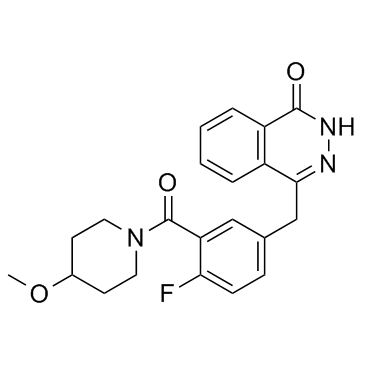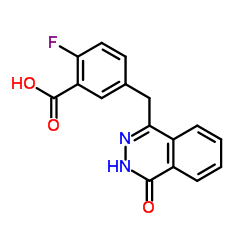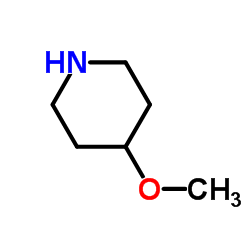1174043-16-3
| Name | 4-[[4-fluoro-3-(4-methoxypiperidine-1-carbonyl)phenyl]methyl]-2H-phthalazin-1-one |
|---|---|
| Synonyms |
1(2H)-Phthalazinone, 4-[[4-fluoro-3-[(4-methoxy-1-piperidinyl)carbonyl]phenyl]methyl]-
4-[4-Fluoro-3-[(4-methoxypiperidin-1-yl)carbonyl]benzyl]phthalazin-1(2H)-one 1(2H)-Phthalazinone,4-[[4-fluoro-3-[(4-methoxy-1-piperidinyl)carbonyl]phenyl]methyl] AZD2461 CS-1402 4-{4-Fluoro-3-[(4-methoxy-1-piperidinyl)carbonyl]benzyl}-1(2H)-phthalazinone AZD-2461||AZD 2461 S7029,AZD 2461 4-(4-fluoro-3-(4-methoxypiperidine-1-carbonyl)benzyl)phthalazin-1(2H)-one AZD-2461 |
| Description | AZD-2461 is a potent PARP inhibitor, with IC50s of 5 nM, 2 nM and 200 nM for PARP1, PARP2 and PARP3, respectively. |
|---|---|
| Related Catalog | |
| Target |
PARP2:2 nM (IC50) PARP1:5 nM (IC50) PARP3:200 nM (IC50) |
| In Vitro | AZD-2461 is a potent PARP inhibitor, with IC50s of 5 nM, 2 nM and 200 nM for PARP1, PARP2 and PARP3, respectively. AZD-2461 (500 nM) shows inhibitory activity against DNA single-strand break repair in human A459 cells. AZD-2461 cuases resistance and high P-gp expression levels in BRCA2-deficient mouse breast cancer line KB2P3.4[1]. AZD-2461 is cytotoxic to BT-20 cells (5-50 μM), increases the proportions of S- and G2-phase BT-20 cells (5-20 μM), and weakly affects the progression of cell cycle in SKBr-3 cells (5-20 μM)[2]. |
| In Vivo | AZD-2461 (10 mg/kg, p.o.) enhances the antitumor activity of temozolomide in a mouse colorectal xenograft and exhibits low effect on mouse bone marrow cells. However, the increased bone marrow tolerability of AZD-2461 is not seen in rat models[1]. AZD-2461 (0.5% v/w HPMC, p.o.) increases the survival of mice bearing KB1P tumors after short-term treatment, and long-term treatment is well tolerated, but can not lead to tumor eradication[3]. |
| Cell Assay | BT-20 and SKBr-3 human primary breast cancer cell lines are used in the assay. SKBr-3 cells are cultivated in DMEM medium with 10% FCS and BT-20 in RPMI medium under an atmosphere containing 5% CO2. Twenty four hours after plating (at 60-70% confluence), the cells are treated with the PARP-1 inhibitors NU1025, AZD-2461, iniparib, olaparib, and rucaparib at concentrations ranging from 50 to 200 μM, 5 to 50 μM, 5 to 50 μM, 1 to 10 μM, and 0.3 to 10 μM, respectively, for durations indicated in figures 1-7[2]. |
| Animal Admin | Starting from 2 weeks after transplantation into mice, tumor size is monitored at least 3 times a week. All treatments are started when tumors reach a size of approximately 200 mm3. Olaparib (50 mg/kg intraperitoneally) and AZD-2461 (100 mg/kg per os) are given for 28 consecutive days, unless otherwise indicated. If tumors do not shrink below 50% of the initial volume, treatment is continued for another 28 days; otherwise, a new treatment cycle of 28 days is started when the relapsing tumor reaches a size of 100% of the original volume. AZD-2461 is diluted in 0.5% w/v hydroxypropyl methylcellulose in deionized water to a concentration of 10 mg/mL[3]. |
| References |
| Density | 1.3±0.1 g/cm3 |
|---|---|
| Molecular Formula | C22H22FN3O3 |
| Molecular Weight | 395.427 |
| Exact Mass | 395.164520 |
| PSA | 75.55000 |
| LogP | 0.53 |
| Index of Refraction | 1.640 |
| Storage condition | -20°C |
|
~74% 
1174043-16-3 |
| Literature: ASTRAZENECA AB Patent: US2011/15393 A1, 2011 ; Location in patent: Page/Page column 7 ; |
|
~60% 
1174043-16-3 |
| Literature: MENEAR, Keith Allan; Javaid, Muhammad Hashim; Gomez, Sylvie; Hummersone, Marc Geoffrey; Lence, Carlos Fenandez; Martin, Niall Morrison Barr; Rudge, David Alan; Roberts, Craig Anthony; Blades, Kevin Patent: US2009/192156 A1, 2009 ; Location in patent: Page/Page column 66 ; |
| Precursor 3 | |
|---|---|
| DownStream 0 | |


